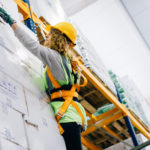 Being able to undertake physical work in a safe way remains a pressing concern, with some 350,000 incidents occurring in the United States in 2017 alone. Among the riskiest places to work are factories and warehouses, where musculoskeletal injuries are common place due to the physical and repetitive nature of the tasks workers are required to perform.
Being able to undertake physical work in a safe way remains a pressing concern, with some 350,000 incidents occurring in the United States in 2017 alone. Among the riskiest places to work are factories and warehouses, where musculoskeletal injuries are common place due to the physical and repetitive nature of the tasks workers are required to perform.
New research from University of Washington has tapped into machine learning to develop an app-based system to monitor factory and warehouse workers and tell them in real-time whether their actions are risking their health.
“Right now workers can do a self-assessment where they fill out their daily tasks on a table to estimate how risky their activities are,” the researchers explain. “But that’s time consuming, and it’s hard for people to see how it’s directly benefiting them. Now we have made this whole process fully automated. Our plan is to put it in a smartphone app so that workers can even monitor themselves and get immediate feedback.”
Live support
The self-assessments currently used rely on workers taking a snapshot of each task, with the position of each joint then given a score, with the total sum then used to determine the risk associated with that particular pose. Suffice to say, it’s a far from perfect approach, and so the researchers turned to machine learning to improve matters.
The researchers video’d workers in action, and used the footage to train a machine learning algorithm to tot up the scores for the various activities performed by workers during their day.
“One of the tasks we had people do was pick up a box from a rack and place it on a table,” the researchers explain. “We wanted to capture different scenarios, so sometimes they would have to stretch their arms, twist their bodies or bend to pick something up.”
The data, which was captured using a Microsoft Kinect camera, was fed into an algorithm so that not only could the risk for each activity be computed, but the specific action that contributed to the risk identified.
Put into action
The team are looking at getting the technology into the hands of workers now, with development work being done on a mobile app that will provide real time warnings to workers whenever their actions are putting their health at risk.
The potential was illustrated during the research when they utilized robotic technology to provide a real-time score to workers. The risk score was displayed on a screen built into the robot within a few seconds of performing various activities, allowing workers to gauge the riskiness of their work habits.
“Factories and warehouses have used automation for several decades. Now that people are starting to work in settings where robots are used, we have a unique opportunity to split up the work so that the robots are doing the risky jobs,” the authors conclude. “Robots and humans could have an active collaboration, where a robot can say, ‘I see that you are picking up these heavy objects from the top shelf and I think you may be doing that a lot of times. Let me help you.'”